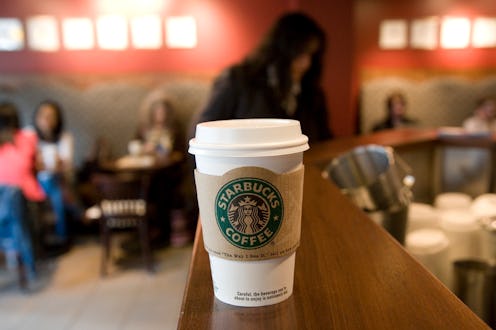Food
Why Starbucks’ Blonde Espresso Is Perfect If You Hate Bitter Coffee
A former Starbucks barista weighs in.

If you, like me, are mourning the fact that Starbucks' holiday menu only comes around once a year, there's an awesome espresso drink at the coffee chain — that you may or may not have heard about — that will make you perk up first thing this morning — even if you haven't had your first cup of coffee yet. So, what exactly is this miracle drink? Well, it’s the Starbucks Blonde Espresso. Find out exactly what the Starbucks' Blonde Espresso is, and how it will change the way you order morning coffee, below.
Coffee isn't for everyone. I'll admit that it took me a few rejected sips and years of drinking tea to develop a taste for it. It wasn't until I felt awkward declining a cappuccino at a café in Rome that I took a polite sip and found that, surprisingly, I liked the mighty espresso and frothy milk concoction. I was enlightened, or more literally, awakened. My reaction was probably due to the fact that the drink wasn't so strong — instead, it was smooth, and the espresso didn't overpower my tastebuds. That's what Starbucks' Blonde Espresso is all about. You may have noticed that Starbucks sells a few different blends of brewed coffee, from their Pike Place medium roast to their Blonde light roast — whereas the Pike Place tastes a bit stronger and bitter, the Blonde roast is lighter, and smoother. “The blonde espresso is better in terms of flavor since it isn’t as harsh ... it’s going to have a lighter, more citrusy flavor, causing it to taste a bit more acidic,” former Starbucks barista Michael Verhoek tells Bustle. Need another reason to go blonde? “It mixes better with other flavors when made in a latte since the espresso isn’t really battling the other flavors of the latte.”
Now, the new Blonde Espresso is similar when compared to Starbucks' other espresso blend: It's a lighter roast, so it's not as bitter. This makes it a universally enjoyable option that even people who don't like bitter coffee may find appealing.
If you think an espresso is too much coffee to handle without the suppressing support of milk and sugar, I recommend ordering the new Blonde Espresso lovers, whether you're someone who can weather a double shot dark espresso or are someone who's just starting to develop a taste for something other than tea.
So how much caffeine in in Starbucks’ Blonde Espresso? The "light roast" has a "natural sweetness" but don't be fooled. "Light" doesn't mean less caffeine. According to Starbucks in a press release, "contrary to popular thought, this light roasted espresso has just as much caffeine as its dark roasted sibling!" Phew. With a lighter roast, we can still all get the usual jumpstart we need for a day of sifting through emails, managing our group texts, and nailing that presentation. As for how it tastes, Starbucks continued, "to make Blonde Espresso, our coffee team lightly roasted Latin American and East African beans to bring out their bright, sweet citrus notes and smooth body — Blonde beverages have hints of lemon, orange and caramel." For those who are curious about that espresso life, this is the perfect roast for you to join the fam.
“There is about 150 mg of caffeine in the signature espresso and 170 mg of caffeine in the blonde espresso,” adds Verhoek. “However, in terms of flavor, the blonde espresso is not going to taste as bitter as the signature.”
Additionally, this drink made Starbucks history. According to Starbucks, it was the first time in 40-plus years that a new espresso was introduced to the permanent menu. So, it was kind of a big deal. Customers have the option to choose their own adventure when it comes to espresso drinks. When you make it to the counter to place your order this morning, be a part of history of make it a Blonde latté.
Additional reporting by Siena Gagliano.
This article was originally published on